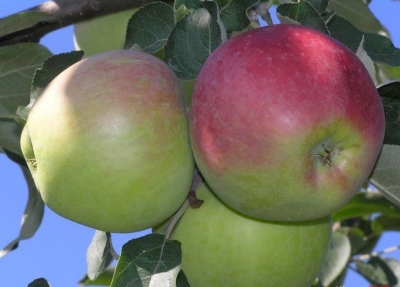
- Authors: All-Russian Research Institute of Breeding of Fruit Crops, E. N. Sedov, Z. M. Serova, G. A. Sedysheva, E. A. Dolmatov
- Taste: sweet and sour
- Fruit weight, g: 160
- Fruit size: above the average
- Yield: 5-8 years old trees give 23 kg per tree
- Ripening terms: late summer
- Removable maturity: in the conditions of Oryol comes August 15-20
- Duration of the consumer period: about a month
- Appointment: fresh, making jam
- Appeared when crossing: Orlik x Tetraploid Paping
Augusta is an apple variety obtained by specialists from the All-Russian Research Institute for Breeding of Fruit Crops by crossing the varieties Orlik and Papirovka tetraploid. The apple tree Augusta is gaining more and more popularity in gardening circles.
Description of the variety
The plant is characterized by the following external differences:
- a tree 4-4.5 m high, the crown is round, spreading, thin;
- branches grow rarely, almost perpendicular to the trunk, the tops look up;
- shoots are thick, straight, brown in color, have a downy;
- leaves are light green, large, wide, oval, pointed, matte, wrinkled.
Features, pros and cons
Among the features of the August apple tree, the following advantages are worth noting:
- excellent productivity;
- annual harvest;
- scab resistance;
- pleasant taste.
The disadvantages include a short storage time for fruits, but this problem can be solved, since August apples are well suited for processing, especially for making jam.
Ripening and fruiting
August belongs to varieties with late summer ripening, fully ripe apples can be removed on August 15-20 (in the conditions of Orel). The duration of the consumer period is limited to one month.
Yield
Trees at the age of 5-8 years give 23 kg of fruit each.
Fruits and their taste
The apples of the presented variety are colored green or greenish-yellow, there is a slight blush on the peel; the shape is oblong, conical, beveled. The size is large, weight - 160 g. The skin is smooth, glossy, covered with large, pronounced subcutaneous punctures. The pulp is greenish, juicy, coarse-grained, the taste is sweet and sour - estimated at 4.4-4.5 points out of 5.

Growing features
Before planting your crop, pay attention to the following factors.
- Easier survival is observed with spring planting. However, when using planting material with a closed root system, the plant can be planted at any time.
- Variety Augusta grows well in sunny areas. If the tree is planted in a low area where the last snow stagnates, then this can negatively affect the quality of the crop.
- The most suitable soil is black soil, loam, gray forest soil. If it is not possible to plant a tree in such conditions, then lime should be added to the acidic soil, and the clay soil should be diluted with sand.
- For planting, seedlings are chosen at the age of 1-2 years.
To create optimal conditions for the development of culture, use the following recommendations.
- Water young plants twice a month; for mature plants, irrigate once a month. The volume of water at a time is 60 liters per tree.
- Dig up the near-stem zone and loosen it twice a year so that the roots get enough moisture.
- After planting in spring, cut the seedling straight away, leaving a meter in height. After that, every year the plant can be cut by a third, forming the correct crown shape. Do not forget about sanitary pruning, during which damaged weak shoots are removed.



Pollination
August is not a self-fertile variety. For pollination, you can use apple trees of other varieties with similar characteristics, for example, Melba or Medunitsa.
Top dressing
Fertilizers should be applied from the second year after planting according to the following scheme:
- spring - nitrogen compounds;
- summer - potassium-phosphorus mixtures;
- autumn - organic feeding.

Frost resistance
Augusta is highly frost-resistant and can withstand temperatures down to -35 degrees. In this regard, the variety is increasingly becoming popular for cultivation in the northern regions of Russia. However, in order to help the tree survive this difficult time, it is worth preparing it, namely:
- remove carrion and debris from the trunk circle;
- clean the barrel and whitewash it;
- cover the plant with spruce branches, which will not only protect the crop from frost, but also prevent damage to the trunk and shoots by rodents.

Diseases and pests
The apple tree of the presented variety has a high immunity to scab and powdery mildew, but occasionally it can be affected by cytosporosis and other ailments. To prevent this, you should provide the tree with optimal conditions, as well as treat the culture with fungicides and insecticides.
Reviews
Basically, the variety receives high marks from gardeners, the fruits attract with their taste and aroma, there is a high winter hardiness of the tree and its high immunity against the frequent apple enemy - scab. Some summer residents were not completely satisfied with the taste of apples, noting that more “tasty” varieties ripen at the same time and under the same conditions. Also, of the minuses, there is a short shelf life for apples.

The apple tree is a popular fruit crop among gardeners.It can be found in many summer cottages. But at the same time, such trees are often affected by various diseases. It is very important to recognize the disease in time and carry out the necessary procedures for a speedy recovery. Otherwise, the fruits will be spoiled, and the tree itself may die altogether.












































































